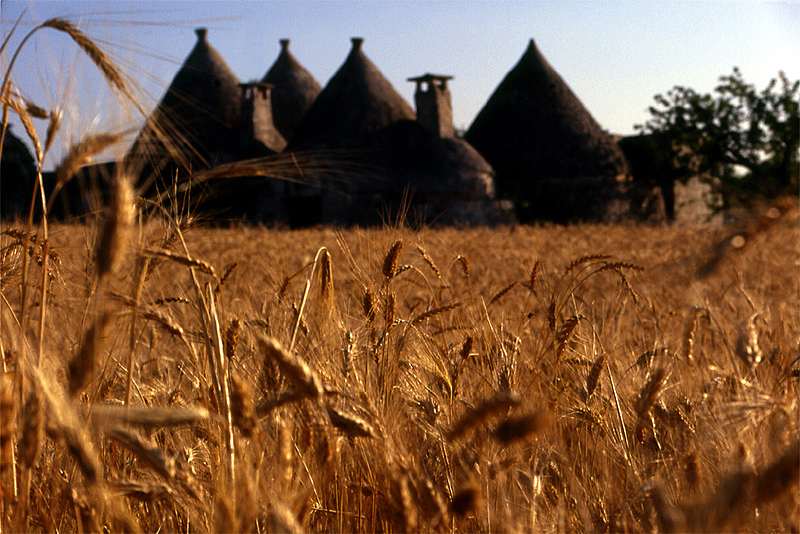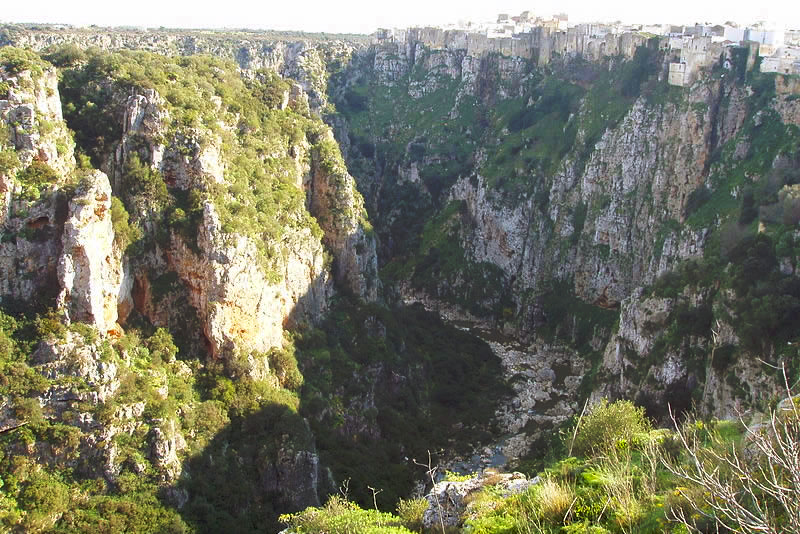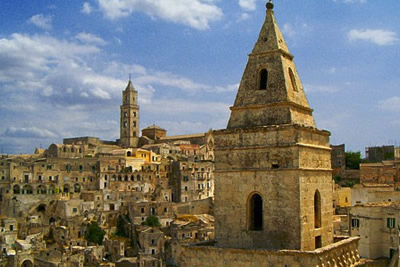Valle d’Itria

Valle d’Itria is an area in central Puglia ranging across Bari, Brindisi and Taranto provinces. It overlaps with the southern part of the Murgia plateau, and strictly speaking, it is not a valley but a karstic depression. Valle d’Itria’s most striking feature is its trulli, typical and exclusive stone dwellings shaped like a cone, and the area has a sprinkling of limestone caves, including the famous Castellana Caves. Also known as Trulli valley, it spans the towns of Locorotondo (near Bari), Martina Franca (Taranto) and Cisternino (Brindisi) plus Alberobello, Putignano, Turi, Conversano, Monopoli, Gioia del Colle, Castellana Grotte, Noci (Bari), Ostuni, Ceglie Messapica and Fasano (Brindisi).
Martina Franca is the area’s highest and largest town (with about 50,000 people). The flora is a mix of woodland and Mediterranean maquis, interspersed with numerous vineyards producing excellent white wines, such as Locorotondo DOC and Martina Franca DOC, and centuries-old olive groves yielding extra virgin olive oil.
Terra delle Gravine park

Terra delle Gravine regional natural park was established in 2005 to protect Puglia’s wildlife and countryside heritage. It extends over parts of Bari, Brindisi and Taranto provinces, in the Murgia area. The impervious terrain gives the park characteristic flora and fauna.
You can encounter many small birds of prey from the lanner falcon, kestrel and lesser kestrel to the black kite, buzzard, short-toed snake eagle, Egyptian vulture (now very rare) and long-eared owl. The park’s others feathered dwellers include common ravens, swifts, barn owls, little owls and great tits. Bats are common at night.
The park’s ponds are home to frogs, newts and toads, in particular the yellow-bellied toad, a characteristic resident of southern Italy’s gorges. The commonest mammals are the fox, porcupine, badger, boar and small rodents like the dormouse. Reptiles include the four-lined snake, the viper and the less dangerous lizard and tortoise. A familiar friend is the “Puglian” Kotschy’s gecko, aka lucertola m’bracidita (the rotten lizard) in the popular tradition. The plant life, meanwhile, includes the holm oak, Aleppo pine, strawberry tree, ash, carob tree, maple and wild asparagus.
Matera

Matera is a town of 60,000 people, a provincial capital and the Basilicata region’s second most populous settlement. It is known all over the world for its historic Sassi districts, the first location in southern Italy to become a UNESCO World Heritage Site, in 1993. The town is in eastern Basilicata, 1,315 ft above sea level, at the border with the south-western part of Bari province (with the towns of Altamura, Gravina in Puglia and Santeramo in Colle) and the north-western tip of Taranto province (with the towns of Ginosa and Laterza). It stands where the Murgia plateau in the east meets the gorge hewn by the River Bradano in the west. The river’s path is blocked by a dam built in the late 1950s for irrigation purposes, and the artificial lake thus created – San Giuliano lake – forms part of San Giuliano regional nature reserve. The Gravina di Matera stream joins the Bradano from the left, flowing in the deep natural gorge that delimits the town’s two ancient districts: Sasso Barisano and Sasso Caveoso. On the other side is Murgia, protected by the Regional natural, archaeological and historical park of the Rupestrian Churches.










